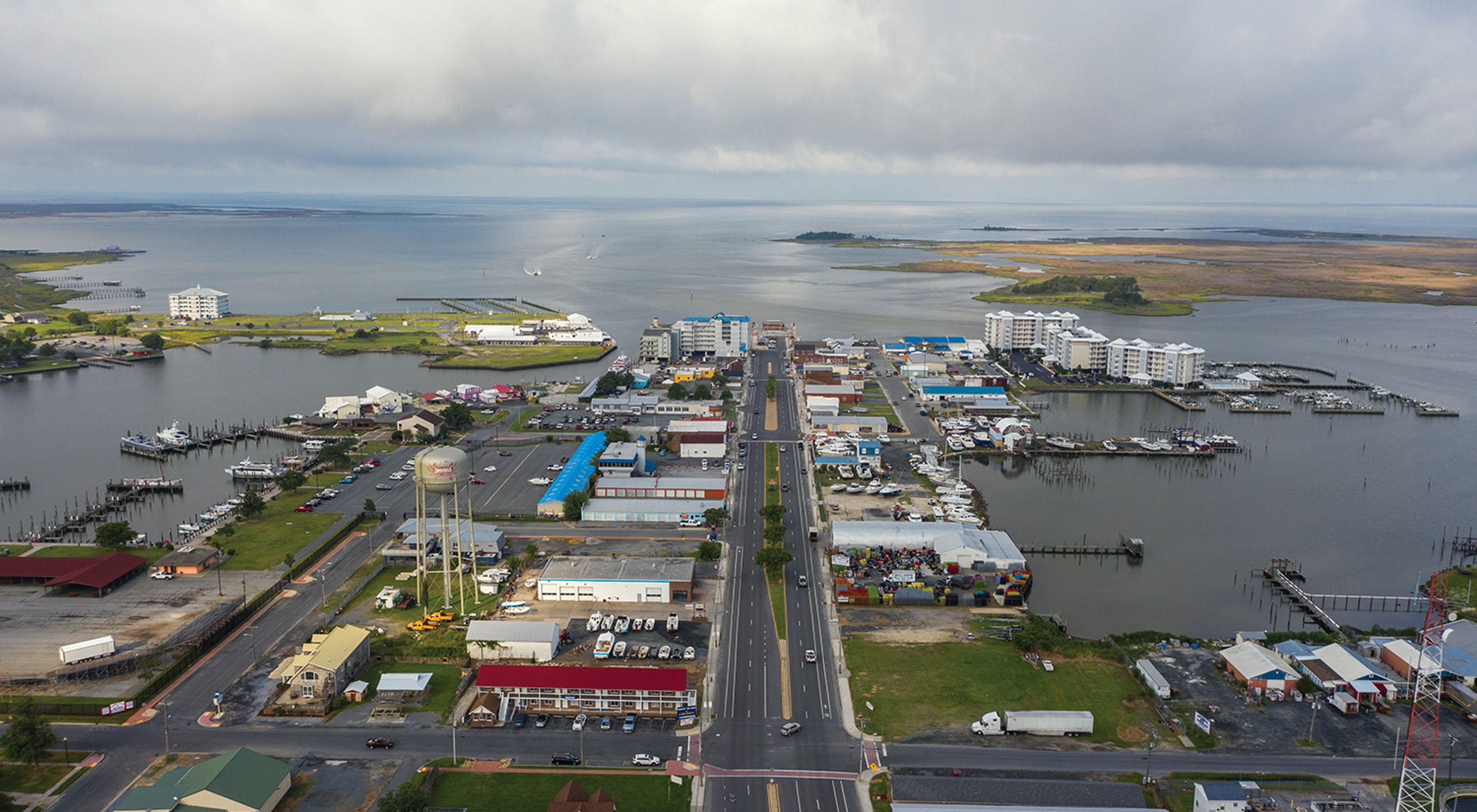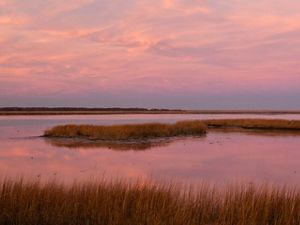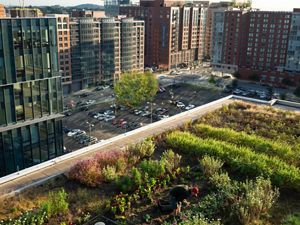Building a Resilient Community in Maryland
A coalition of partners are working in Crisfield, Maryland to demonstrate a new model for building resilience to environmental challenges.
Media Contacts
-
Matt Kane
The Nature Conservancy
Phone: 323-898-6510
Email: matthew.kane@tnc.org
A coalition of partners that includes the public sector, private sector and members of the local community has emerged over the past year in Crisfield to tackle the immediate issue of flooding as well as long-term planning for the city’s future as it considers a range of environmental impacts. Representatives from these partners presented on their respective projects at an October community meeting, which can be viewed on the City of Crisfield’s Facebook page.
The city of Crisfield sits on the Lower Eastern Shore of Maryland at the edge of the Chesapeake Bay, and is locally celebrated as the “Crab Capital of the World” thanks to its thriving oyster and crabbing industries that helped put the city on the map in the 19th century. Crisfield’s seafood industry remains a critical part of Crisfield’s economy, as does its growing tourism economy.
Unfortunately, Crisfield’s low elevation and proximity to the Bay have made it especially vulnerable to increasing flooding over the years, which is actively impacting the community and hampering economic growth. Tides have become more extreme, leading to more frequent nuisance flooding on roads that impedes access to important parts of the community. Even smaller storms are having a more severe impact, often forcing schools and businesses to close and leaving property owners with expensive damage and losses. As in many small coastal communities, the severity of these impacts has been disproportionate to resources available to address them.
“Crisfield is the gateway to the Chesapeake. It lies at the crossroads of American history and God’s beautiful wonders,” said longtime resident John Ward. “From its old-time charm and natural beauty, to its intoxicating and resilient community, it stands as a true treasure for both the local area and beyond that needs to be preserved.”
A variety of partners have begun working with the City of Crisfield and members of its community to address these challenges, with the Eastern Shore Long-Term Recovery Committee being one of the first. More recently, The Nature Conservancy (TNC), University of Maryland’s (UMD) Environmental Finance Center (EFC), George Mason University (GMU), Federal Emergency Management Agency (FEMA) Building Resilient Infrastructure and Communities (BRIC) Direct Technical Assistance (DTA), United States Environmental Protection Agency’s (EPA) Office of Research and Development (ORD) and Office of Water-Creating Resilient Water Utilities (CRWU) initiative and Interfaith Partners of the Chesapeake have joined them. This coalition has helped to build local capacity and improve access to resources and technical assistance.
"You achieve what you focus on, and having so many resilience partners focus on Crisfield's flooding challenges has been phenomenal,” said Crisfield Mayor Darlene Taylor. “Bringing together the community and local government and providing capacity for research and analysis that a small town like ours would never have been able to accomplish with our limited resources."
The Nature Conservancy identified Crisfield as a place where they could help improve community resilience to flooding. Starting in 2022, TNC collaborated with UMD EFC and GMU to begin a NOAA-funded project to assess the benefits of potential new flood adaptation strategies to support the City’s planning efforts. The team hosted a series of workshops with a Community Advisory Committee to ensure Crisfield’s social and economic goals were an integral part of Crisfield’s flood planning initiatives, which were supported by funding from Lockheed Martin.
Another important goal of the project was to create new collaborations between Crisfield’s community leaders, residents and outside partners to increase local capacity and help move forward flood adaptation projects that benefit a range of community needs and goals. This collaborative model could be replicated in other communities facing similar challenges to better help them take charge of their futures with the support of a robust coalition of partners. A NOAA-funded report is expected in the next few months from UMD EFC, GMU and TNC that will provide modeled flooding and adaptation scenarios and cost-benefit analysis of the potential strategies.
”Crisfield is a community with a lot of determination and big ambitions for their future, despite the flooding challenges they face,” said Dr. Elizabeth Van Dolah, Environmental Anthropologist with the Maryland and DC chapter of The Nature Conservancy. “We hope the efforts we’re supporting in Crisfield can be a model for empowering other communities in the region to self-define what community resilience looks like for them and integrating those goals into planning for a future with a changing climate and more water.”
Other resilience-improvement projects that are currently underway include the City’s creation of an early flood warning system and an effort to map all of Crisfield’s drainage infrastructure. The Eastern Shore Long-Term Recovery Committee have built new, affordable, flood-safe homes in Crisfield for a number of years and is currently elevating additional homes.
“Crisfield has been working with FEMA as part of the Building Resilient Infrastructure and Communities Direct Technical Assistance (BRIC-DTA) program since October of 2022,” said FEMA Region 3 Regional Administrator MaryAnn Tierney. “As part of BRIC-DTA, Crisfield has developed a mitigation strategy and is seeking FEMA BRIC funding to advance mitigation projects that will reduce flood risk across the city. Additionally, DTA has supported community partnerships and engagement with Crisfield stakeholders and residents alongside important partners, such as TNC, EPA, UMD EFC, GMU and local organizations focused on resilience. FEMA will continue to support Crisfield in advancing resilience through BRIC-DTA until 2025.”
The FEMA BRIC DTA’s partnership with local government has been integral to coordinating across multiple resilience initiatives, including TNC’s, to develop a competitive proposal of implementable mitigation projects that include tide gates, berms, bioretention ponds and elevated roads.
The EPA ORD is working with Crisfield to explore how nature-based solutions such as green infrastructure and marsh restoration can support the community’s long-term resilience. Earlier this year, the EPA CRWU conducted an assessment of the current tidal ditch drainage system to help support the City’s efforts to make their drainage infrastructure more climate resilient. Building upon these efforts, UMD EFC through the Region 3 Water Technical Assistance (WaterTA) program will be working with Crisfield in the coming years to address funding and financing for water and wastewater infrastructure resilience. EPA ORD and Interfaith Partners of the Chesapeake will also be providing local leadership training opportunities for community members. EPA ORD will be offering a six-month Resilience Academy open to local residents aged 15 and older who want to be part of these broader resilience planning efforts, while Interfaith Partners of the Chesapeake will be providing leadership trainings for developing green infrastructure projects.
“The proposed mitigation strategies and community resilience projects which ensued from the collaboration will be truly transformational for our community,” said Mayor Taylor. “We could not be more grateful to The Nature Conservancy, FEMA BRIC DTA, the EPA and the numerous other agencies for the countless hours that have gone into bolstering the sustainability of Crisfield."
The City of Crisfield is currently seeking matches for grant funding, which TNC will also be supporting while exploring what the next phase of the work may look like. More details on projects underway in Crisfield can be found at www.crisfieldfloodmitigation.com.
The Nature Conservancy is a global conservation organization dedicated to conserving the lands and waters on which all life depends. Guided by science, we create innovative, on-the-ground solutions to our world’s toughest challenges so that nature and people can thrive together. We are tackling climate change, conserving lands, waters and oceans at an unprecedented scale, providing food and water sustainably and helping make cities more sustainable. The Nature Conservancy is working to make a lasting difference around the world in 81 countries and territories (40 by direct conservation impact and 41 through partners) through a collaborative approach that engages local communities, governments, the private sector, and other partners. To learn more, visit nature.org or follow @nature_press on X.



